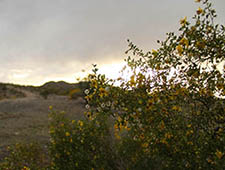Cronkite News has moved to a new home at cronkitenews.azpbs.org. Use this site to search archives from 2011 to May 2015. You can search the new site for current stories.
After dry winter, Arizona’s famous wildflower blooms may be busts
PHOENIX – The annual spring explosion of yellow, purple and blue wildflowers in the Arizona desert may be lackluster this year because of the dry winter.
That’s bad news not just for wildflower aficionados but for communities that rely on blooms that bring people to places like Boyce Thompson Arboretum in Superior.
“Photographers plan trips to Arizona to photograph carpets of color,” said Paul Wolterbeek, a coordinator and wildflower guide at the arboretum. “They’ll consider other destinations this year.”
Desert wildflowers such as purple desert lupines, the boisterously red indian paintbrush and the rare gold columbine flower in higher elevations typically bloom in March and April.
The soil was primed for germination because of an uncharacteristically wet November, but there’s been scant rainfall since.
As of late February, Phoenix hadn’t seen a drop of rain in 2014, while Tucson had received only a trace, according the National Weather Service.
Wildflowers need at least an inch of rain in late fall to germinate, followed by another inch per month through March to sustain their growth, said Ray Leimkuehler, a horticulturist with the Desert Botanical Garden in Phoenix.
Another essential for wildflowers is optimal soil temperature – warm, but not as warm as it’s been of late.
Things have been looking so bleak that Arizona State Parks might not offer its traditional “Ranger Cam” helping wildflower lovers find the most stunning displays, according to Ellen Bilbrey, a spokeswoman for the agency.
“There’s won’t be much to see, and people shouldn’t come to Arizona just for the wildflowers,” she said.
The Desert Botanical Garden plans to launch a website March 1 that will provide updates of the best bloom sites. And while Mother Nature hasn’t cooperated of late, horticulturists have spent months tending to the botanical garden’s penstemon, desert lupine and poppies, which are expected to bloom in March and April.
Boyce Thompson Arboretum will still offer wildflower walks along U.S. 60 and into the Superstition Mountains.
The arboretum’s Wolterbeek said those looking for blooms elsewhere will have to be strategic. The trick is looking for places that hold water, such as dunes, road shoulders and bases of boulders, he said. The best time to look is midday, when flowers get the most sun.
Mexican gold poppies were blooming this week at Lost Dutchman State Park in the East Valley. While the yellow flowers usually carpet the park, now there are only patches, Park Ranger Tim Kristof said.
“You have to hike really far to see anything now,” he said. “Even then there’s not much to see.”
Sparse, dying golden brittlebush buds can be seen along the Javelina Trail at the east end of South Mountain Park in Phoenix, ranger Allyson Pacini said.
Bluebell flowers, which are deceptively more purple than blue, barely dot the 1.7-mile hike, far fewer than usual.
“People come either way,” Pacini said. “This is Arizona’s best time of year.”
Enthusiasts can hold on to some hope, as rain showers can still coax thirsty flowers to flourish.
“Arizona wildflowers are a treat; it’s not something that happens all the time,” said Ray Leimkuehler at the Desert Botanical Garden. “With seasons like these we learn to value it more.”







